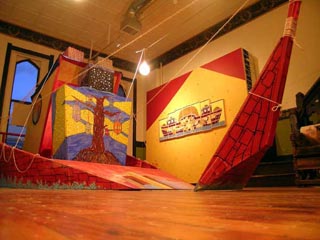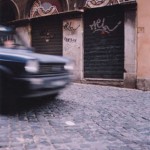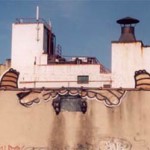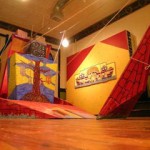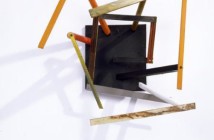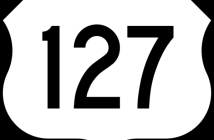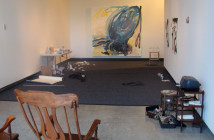Graffiti art has been infiltrating its way into the “official” art world for more than two decades now. With artists like Jean Michel Basquiat and Keith Haring, to name only two of the most well known, paving the way for more contemporaries like Barry McGee and Margaret Kilgallen, the art of graffiti now seems to reside quite comfortably in the gallery world. Perhaps one of the most pressing questions about this phenomena, at least for this writer, is once graffiti leaves the street, is it really graffiti anymore? As a definition, street art resides in the street and to take it into the white cube is to take mere style and force it into a context, thus making graffiti convenient to sell, market and commodify. To this end, the “art of graffiti” vs. “the graffiti artist” is worth highlighting.
The recently opened exhibition, Spothunters at the New Art Center in Newton, brings together a different sensibility to the relationship between street art and studio/gallery art practices by placing publishing in the same category. To this end, each of the four artist’s approaches a venue like the New Art Center as just another location. However, the artists of Spothunters do well to complicate this over-simplified notion. Like “old school” graffiti artists, always adaptable and mobile, the artists of Spothunters come equipped with an array of personal icons, identifiable “signatures”, zines and stickers.
Caleb Neelon, the curator of the exhibition, makes certain to site that the artists are not particularly invested in being “official graffiti artists or “official” gallery artists, although the latter is debatable. Neelon and the other artists are very aware of straddling these platforms. For instance, when making a tag in the street, the artist may only have 2 minutes or less to perform it. While a gallery artist’s time frame can be much longer. Either way, the important thing is to be armed and ready for whichever situation arises – and to document it.
Each artist’s strategy varies greatly. Caleb Neelon’s paintings of buildings, haystacks, boats, rhinos and birds also manifest themselves onto a large boat where the hull, cabin and other parts are subject to the same type of imagery. In this sense, the surface of the boat is a vehicle for the images that run through all of the paintings. Conventional in format, but lively in execution, Neelon’s paintings embody “the look” of graffiti but are clearly “gallery works.” The boat, on the other hand, is difficult to categorize. In one sense, it feels to be a readymade element onto which Neelon worked his style. Irregardless, its impact cannot be underestimated as its color and scale give it a fantastic presence.
The collaborative group “Monster Project” have painted and installed pictures of a monster across Rhode Island, Massachusetts, Rome, and New York. Invading doorways, archways and buildings alike, the monster seems to become part of the architecture in which it is placed. The battle, so to speak, is how long it can stay in its habitat before it is tagged over or cleaned up. However, the documentary photographs of the monsters are a project within itself and are represented in a makeshift pavilion in the middle of the New Art Center gallery. Resembling a trade show walk-in, the installation is a very funny and effective display for a public project.
Other works in the show incorporate the street language of graffiti literally, such as when corrugated aluminum is brought into the gallery to simulate the side of a building. Here, street signs and tags are used like collage elements making the gallery wall a façade for “real” graffiti. Other works blend contexts and formats more seamlessly, like Shepard Fairey’s works, the most widely known artist in the show. Fairey is represented by a few photographs of public interventions, as all the artists are for that matter, like his widely spread Andre the Giant logo that has been tagged just about everywhere in the world. Fairey’s work seems to be the one that crosses contexts the easiest, especially considering the screens that make his considerable amount of posters are also used to make just about all of his work. Fairey’s eagerness to accommodate virtually any context and “tag” not only the streets, but also print ads, posters and galleries, make him probably the most calculated spothunter of the group, and also the most widespread.
While the “official” art world is always eager to import styles and contexts into its matrix, (comic books have also emerged in a very similar manner), artists are just as quick to adapt and make use of the opportunites. If Spothunters is any indication of the level at which artists are taking advantage, then the “art of graffiti” is in good hands.
Links:
The New Art Center
Shepard Fairey
Monster Project
Caleb Neelon
"Spothunters" is on view at the New Art Center in Newton from March 6th-April 7th, 2006. The opening reception for the artists will be held on Friday, March 10th from 6-9 pm.
All images are courtesy of the artists and the New Art Center.

